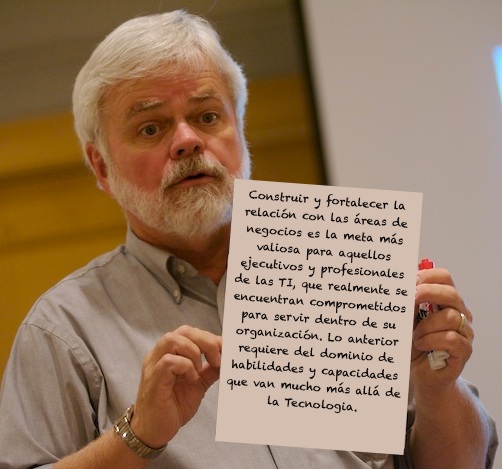Taller: Strategic IT Management con Bob Benson
The Capabilities every IT Manager, Professional (and Business Executive) Requires for these Turbulent Times
Strategic IT Management forcefully presents the IT culture, structure, and process transformations necessary to cope with today’s business, government, and technology turbulence and sea changes. These sea changes transform business and government, often enabled by IT and always greatly affecting what IT has to do for the business and government. CIOs and IT professionals must excel in their business-facing capabilities and excel in agility and responsiveness to the forces facing business and government organizations.
The focus in on the competencies CIOs must have with relation to the business and the changes and forces affecting business. In business terms, CIOs have to manage and shape how these transforming technologies are to be used in the business and government. This requires CIOs to bridge the gap between IT and business, with sound and practical business-facing capabilities in the context of complex business organizations (e.g., multiple business units, geographies, business governance cultures) and ongoing turbulence and change.
In a fundamental way, this is about achieving IT’s Value in the 21st Century, about managing and shaping the IT and business future.
The Strategic IT Management framework consists of seven business-centric core competencies – the business-facing things that CIOs and IT organizations have to be capable of doing well. The Strategic IT Management framework also incorporates significant business requirements which engage the CEO, business unit executives and business professionals. A development and improvement roadmap defines the management processes required to achieve the needed level of competency. A maturity model helps a CIO determine where his or her IT organization stands. The outcome is a partnership between business and IT, established through the seven core competencies, enabled by the leadership provided from the CIO and IT professionals.
Format
This One day Workshop combines lecture (applying materials and tools distributed to each participants) with in-class workshop exercises designed to show how the lecture concepts apply to each participant’s organization.
Several real-world cases will illustrate the key points and their application in government and business organizations.
Benefits
The Workshop covers in detail the seven critical business-focused capabilities CIOs and IT Organizations (and the business executives with whom they work) must have. These capabilities are particularly necessary today, as turbulence and change increasingly characterize business, government, and the global economy.
Each participant receives:
- Self assessment tools for understanding the problem in the participant’s own organization, namely turbulence and the continuing gaps between business and IT.
- Clear understanding of the Strategic IT Management concepts and frameworks
- Self assessment tools for defining the importance and potential application of Strategic IT Management concepts and frameworks.
- A Roadmap for moving forward, tailored to each participant’s own organization.
In short, the workshop benefits provide an important and effective starting point for getting the benefits of Strategic IT Management for each participant’s unique situation.
Workshop Outline
The Workshop Objective is to give each Workshop participant the key Strategic IT Management concepts, provide a self-test capability for enabling each participant to determine whether the key concepts apply to the participant’s specific business and IT situation, and a roadmap for applying the key concepts into the participant’s own organization.
- Introduction to Strategic IT Management
- The Problem
- Transformational Business and Technology Change
- The Trust and Accountability/Performance Gap between Business and IT
- Workshop One: The Problem (for your organization)
- The Solution
- The Seven Critical IT Management Capabilities
- The Seven Business Management Requirements
- How to determine what is important for each Workshop participant’s situation and organization (e.g., “one size does not fit all”)
- Business/IT Governance
- The Strategic IT Management Roadmap
- Workshop Two: Defining the Solution for Your Organization
- Key Foundation Concepts
- Business and IT Mission and Vision
- Business and IT Strategic Intentions
- Business and IT Strategic Activities
- Governance
- Details of the Seven Management Capabilities
- Self Assessment Toolkit
- Basic Frameworks, how the Seven Capabilities apply a common framework and the foundation concepts, with focus on the Specific Business and IT outcomes expected
- Planning & Innovation
- Information & Intelligence (e.g., Analytics, Information Architecture)
- Development & Transformation (e.g., SDLC, Agility)
- Service & Resource Optimization (e.g., Portfolio Management)
- Service & Operational Excellence
- Cost & Performance
- Sourcing
- Workshop Three: Application to Your Organization
4.- What’s Next?
- The Strategic IT Management Roadmap
- Identifying the importance and possible application to Your Organization
- Establishing a Practical Roadmap for You
- Workshop Four: Developing the Roadmap
Given the enormous transformational business and IT changes facing every organization, fixing the business IT relationship is vital – a precondition – to enable the business, the IT organization, and managers to prosper in the future. The overall Workshop outcome for participants is understanding how to empathize :
- Build Trust and Partnership
- Adopt proactive behavior – to seek out business opportunity; accept that this is IT’s prime role and responsibility
- Provide distinctive value-add to the enterprise (not just cost)
- Create and execute significantly better projects with greater business impact

